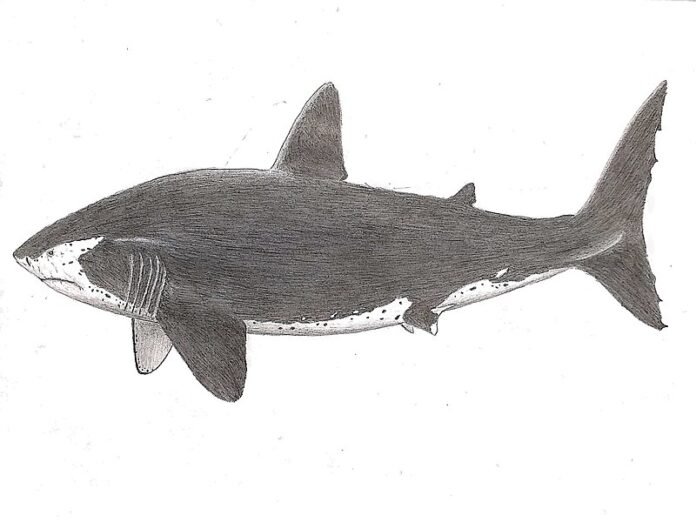Extinct gigantic megatooth sharks were at the top of the marine food web once. Their ebolusyon to gigantic sizes and their extinction are not well understood. A recent study analysed isotopes from the fossil teeth and found that these sharks developed endothermic thermoregulation and evolved to gigantic sizes but the high metabolic costs and bioenergetic demands could not be sustained longer following shrinkage of productive habitats due to climate change and sea level changes. Consequently, they became extinct 3.6 million years ago. This study also brings to fore the fact that like the extinct megatooth sharks, the modern shark species too are not immune to the effects of climate change hence the need for their conservation.
Megatooth Sharks, meaning “big tooth” sharks, were supersized gigantic sharks that evolved in the Cenozoic era, acquired body size of about 15m and became extinct about 3.6 million years ago (Mya) during the Pliocene panahon.

Ang mga higanteng pating na ito ay pinagkalooban ng matatalas, kasing laki ng saging na ngipin at isa sa pinakamalaki sa sukat ng katawan (sa tabi lamang ng asul na balyena). Itinuturing silang isa sa pinakamakapangyarihang marine predator na nabuhay kailanman na nabiktima ng mga balyena, dolphin, seal, at iba pang maliliit na pating.

Sa panahon nito ebolusyon, these sharks had undergone drastic changes in dentition including widened crowns and serrated cutting edges which enabled them to shift from fish-based diet to more energetic marine mammals-based diet. This helped them achieve much richer pagkain which was one of reasons behind their ebolusyon to gigantic body sizes1.
Ang mga megatooth shark ay nasa tuktok ng food web at ultimate predator2. Mayroon silang mas mataas na antas ng tropiko para sa anumang uri ng dagat. (Ang trophic level ay ang posisyon ng isang organismo sa food chain, ito ay mula sa halagang 1 para sa mga pangunahing producer hanggang 5 para sa marine mammals at mga tao).
Paano umunlad ang mga pating na ito sa napakalaking sukat ng katawan at bakit sila naubos mga 3.6 milyong taon na ang nakalilipas?
| Ectothermy | Cold-blooded, kasama ang lahat ng hayop maliban sa mga ibon at mammal. hal, mga pating |
| Mesothermy (o, regional endothermy) | Hayop na may diskarte sa thermoregulatory na intermediate hanggang cold-blooded ectotherms at warm-blooded endotherms. hal, ilang pating, pawikan |
| Endothermy | Ang mga hayop na may mainit na dugo, ay nagpapanatili ng pare-parehong temperatura ng katawan anuman ang temperatura sa paligid, kabilang ang mga ibon at mammal. (Kabilang sa endothermy ang regional endothermy o mesothermy sa malawak na kahulugan) |
Ang mga pating ay mga cartilaginous na isda at mga hayop sa dagat na malamig ang dugo (ectothermic). Ang mga hayop na ito ay walang kakayahan na metabolically taasan ang temperatura ng katawan at panatilihin ang init.
Had megatooth sharks undergone thermo-physiological changes in course of its ebolusyon to acquire endothermic properties? This hypothesis is relevant because unlike cold-blooded (ectothermic), warm-blooded (endothermic) marine animals can have higher cruising speeds and can travel longer distances to catch preys than ectothermic counterparts. Acquisition of endothermic properties (along with transformed dentition) could explain why these sharks evolved to such gigantic sizes.
Sa isang kamakailang pag-aaral na inilathala sa PNAS noong 26th June 2023, researchers investigated thermo-physiology of megatooth sharks to explain its ebolusyon and extinction. They studied geochemical evidence for thermoregulation from clumped isotope paleothermometry and phosphate oxygen isotopes obtained from fossil tooth samples and found that isotope-inferred body temperatures of Otodus species averaged about 7 °C higher than ambient seawater temperatures and other coexisting shark species. An overall warmer body temperature means megatooth sharks had evolved to be endothermic suggesting endothermy was a key driver for their gigantism3. Ngunit ang kakayahang thermoregulatory na ito ay napatunayang magastos para sa mga megatooth shark sa takdang panahon.
Ang mga megatooth shark ay tugatog na maninila sa tuktok ng marine food web2. Their top trophic level diet, gigantic body sizes and endothermic physiology meant high metabolic costs and high bioenergetic demands. The energy balance was disturbed when productive habitats diminished, and sea level changed. This altered prey landscape, and prey become scarce. The consequent food shortage put negative selection pressure against gigantic megatooth sharks culminating in their extinction 3.6 Mya. Endothermy, the key driver in the ebolusyon of megatooth sharks also contributed to their extinction following changes in climate.
Tulad ng mga patay na megatooth shark, ang mga modernong species ng pating ay hindi immune sa mga epekto ng pagbabago ng klima kaya kailangan ang kanilang konserbasyon.
***
Sanggunian:
- Ballell, A., Ferrón, HG Biomechanical na mga insight sa dentition ng megatooth sharks (Lamniformes: Otodontidae). Sci Rep 11, 1232 (2021). https://doi.org/10.1038/s41598-020-80323-z
- Kast ER et al 2022. Sinakop ng mga Cenozoic megatooth shark ang napakataas na trophic na posisyon. Mga Pagsulong sa Agham. 22 Hun 2022. Vol 8, Isyu 25. DOI: https://doi.org/10.1126/sciadv.abl6529
- Griffiths ML, et al 2023. Endothermic physiology ng mga patay na megatooth shark. PNAS. Hunyo 26, 2023. 120 (27) e2218153120. https://doi.org/10.1073/pnas.2218153120
***






































